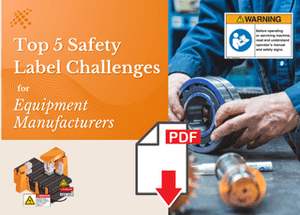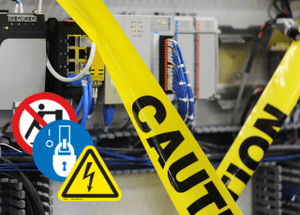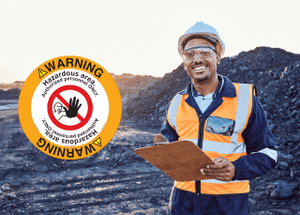How to Identify Emergency Eyewash Stations

As the month of March marks Workplace Eye Wellness Month, there’s no better time for employers to examine their workplace safety protocols, conduct overdue risk assessments, and upgrade their eye safety signage systems – particularly as they relate to emergency eyewash areas. Because of our involvement in the development of the ISO standards for safety signs, here at Clarion Safety, we thoroughly understand safety equipment location sign system design and installation. There’s an immediate need to find the eyewash stations in your lab, your plant’s maintenance department or in your forklift battery charging area. The optimum situation is that the emergency eyewash station is situated where everyone in every corner of that area can see the equipment, or see the sign mounted above the equipment.
When
is an Eyewash Station Required in a Workplace?
It’s important to note that there is
a large difference between emergency showers and eyewash stations in regards to
their use and purposes. Emergency showers are
designed to flush the user's head and body. They should not be used to flush the user's
eyes because the high rate or pressure of water flow could damage the eyes in
some instances. Eyewash stations are
designed to flush the eye and face area only, although there are combination
units that contain both a shower and an eyewash.
Many times, experts will recommend a combination unit with the ability to flush the eyes and face or all of the body. This type of setup is ideal for when complex, hazardous operations involve many chemicals with different properties. Combining an area for an emergency eyewash and shower aids in situations where a worker is in panic and may not be able to follow directions to different areas because of intense pain or shock from an injury.
Determining whether an emergency shower or eyewash station is best for your workplace is based on the properties of the chemicals that are commonly handled and the tasks within. This is where a hazard analysis can provide an evaluation of the potential hazards of the chemicals and the work areas and help integrate the best use of protective equipment.
Regulations on Emergency Eyewash Stations
The OSHA regulations for eyewash stations include the following:
1910.151 C: Where the eyes or body of any person may be exposed to injurious corrosive materials, suitable facilities for quick drenching or flushing of the eyes and body shall be provided within the work area for immediate emergency use.
1910.1200(b)(3)(ii): Employers shall maintain any material safety data sheets that are received with incoming shipments of hazardous chemicals, and ensure that they are readily accessible during each work shift to laboratory employees when they are in their work areas
OSHA refers all other concerns about emergency
eyewashes to the American National Standards Institute (ANSI) and the
International Safety Equipment Association (ISEA).
ANSI/ISEA Z358.1: The American National Standard for Emergency
Eyewash and Shower Equipment standard, most recently updated in 2014, is one of
the best sources for best practice guidelines for the selection, installation,
operation, and maintenance of the equipment.
Where Should Eyewash Stations be
Located?
In a situation where someone needs to use the eyewash station, time is
absolutely of the essence; employees could lose vision or see other damage to
their body if they cannot locate it fast enough. Eyewash signage is for the
safety and convenience of workers who submit themselves to those conditions,
and it’s important that signage is updated and set up properly according to the
latest standards and best practices.
To be effective, the equipment has to be accessible in every facility. ANSI Z358.1 recommends that a person be able to reach the equipment in no more than 10 seconds or 55 feet and on the same level as the hazard so as to prevent any permanent damage if possible. Although, it’s important to note that the "10 second" rule may need to be modified depending on the potential effect of the chemical. Where a highly corrosive chemical is used, emergency showers or eyewash stations may be required to be closer to the workstation, although it’s a good idea to consider consulting a medical professional to determine placement depending on the chemical. These units should always be installed in such a way that they do not become contaminated from corrosive chemicals used nearby.
How Should an Emergency Eyewash be Identified?
According to ANSI/ISEA Z358.1, the location of each emergency eyewash should
be identified with a highly visible sign in a well-lit area. The sign should be
in the form of a symbol that doesn’t require workers to have to read the
language to understand it. Ideally, one of the eyewash station signs should be
atop the location of the eyewash station or kits location, with other
directional signs dispersed throughout the facility as appropriate.
Most commonly, it’s recommended to install large green projecting signs stating “emergency eyewash” with large white font. The size of letters on eyewash station signs should be sufficient to be easily read across your facility. The International Organization for Standardization’s ISO 7010 official graphical symbol for emergency eyewash signs is a green background with white graphics of an eye above running water coming out of a shower head accompanied by a first aid cross. However, ISO does note that the first aid cross can be replaced with another element that is appropriate to the cultural requirements of the workplace.
Selecting a sign can include several different shapes, sizes and materials, including having it protrude from a wall end or corner, enabling people to locate it from many angles. To combat the dark, some signs are even designed with photoluminescent materials to be visible in all situations.
Prepare Your Products and Workplace for Eye Safety
Eye injuries can affect employees for the rest of their lives – and have
serious liability impacts for businesses. The goal for us all is to have zero
eye injuries. Working together, that is entirely feasible. At Clarion Safety,
we’re here to help. Get in touch with us to see which labels, signs, and tags are right
for your project. We can also assist with machinery risk assessments and label assessments.
If you’re ready to order your informational signs, browse our line of visual communication safety products, or create your own with our fast and easy to use online customization tools; whether it’s a ‘Danger’, ‘Warning’, ‘Caution’, ‘Notice’ or ‘Safety Instructions’ message – we have you covered!



